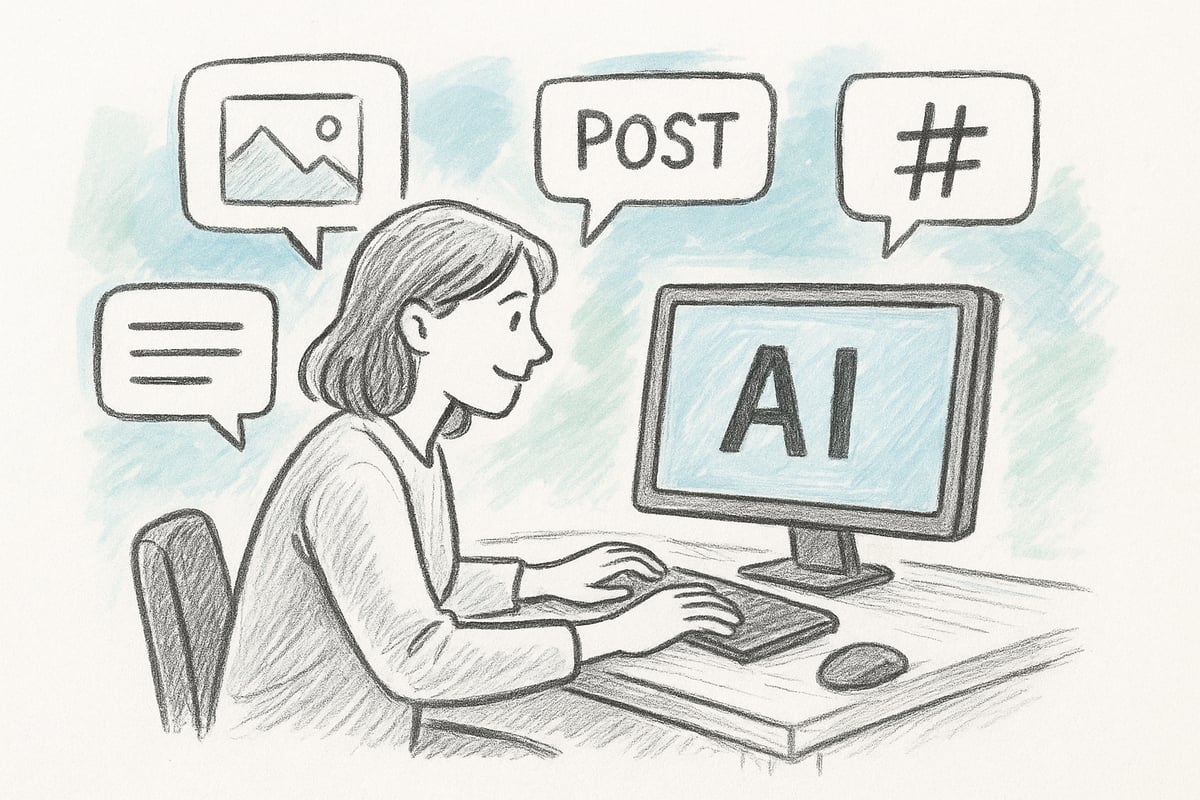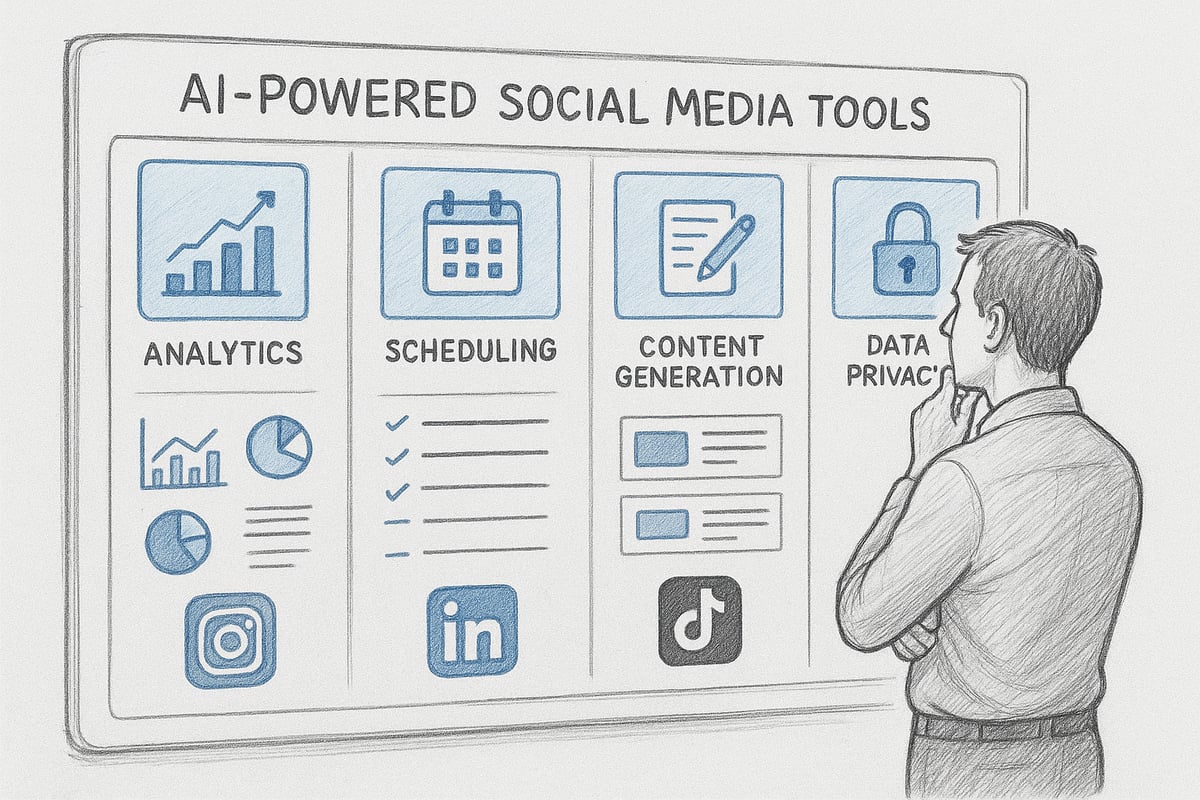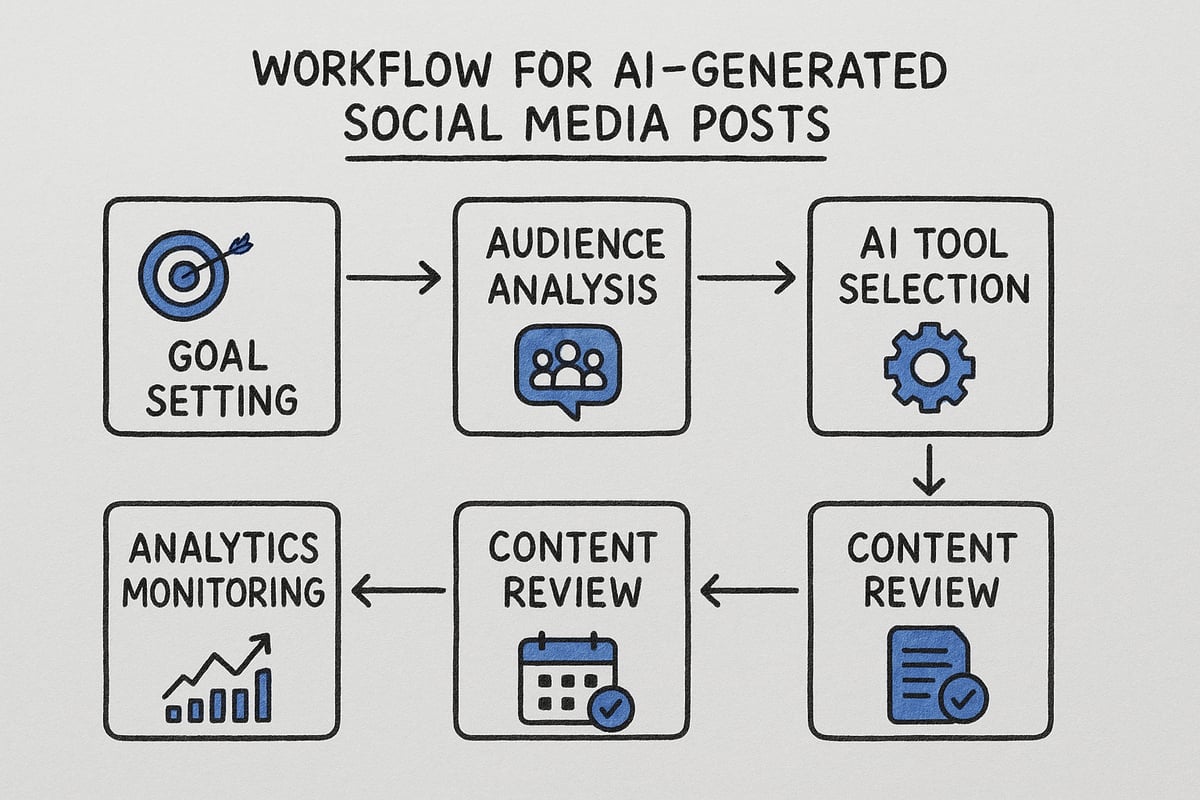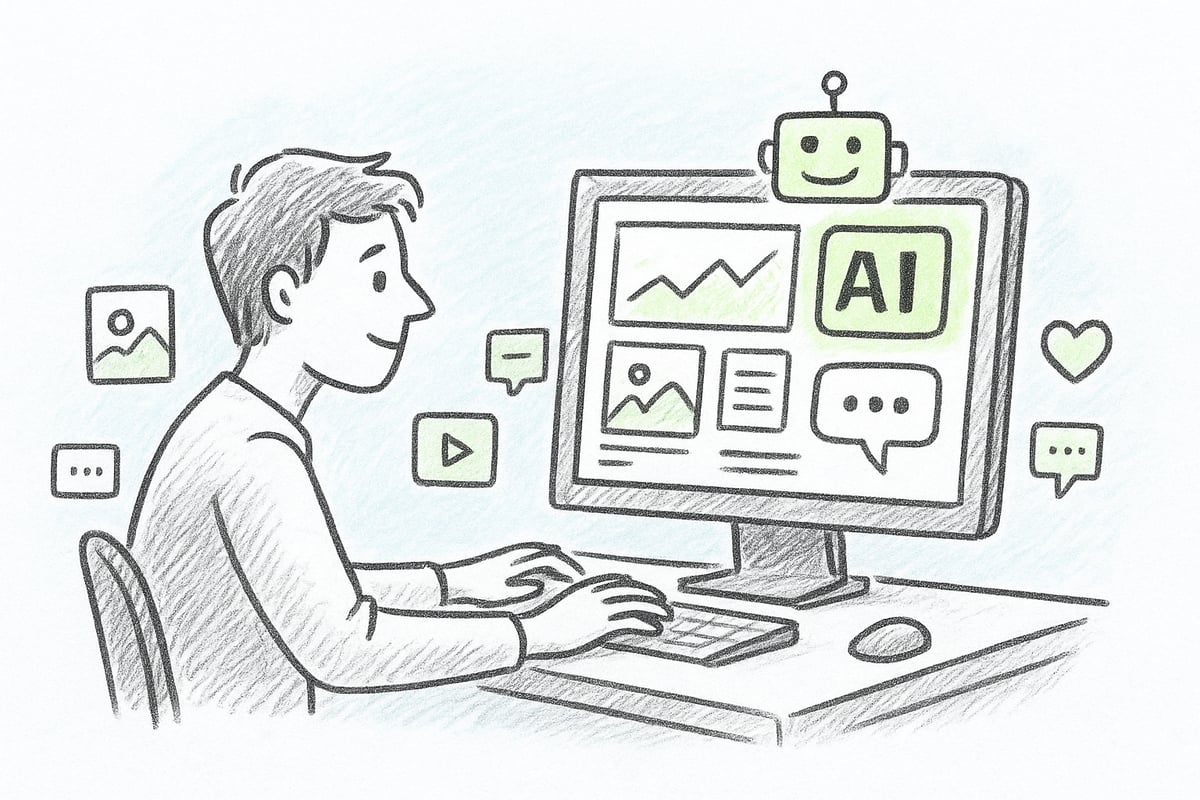AI-generated content is revolutionizing the way brands connect with audiences online, and nowhere is this more evident than in the explosion of ai generated social media posts. Marketers and creators now have access to powerful AI tools that can streamline content creation, personalize messaging, and boost engagement like never before.
This essential guide will show you how to harness AI for your social media strategy in 2025. You will discover the top AI tools, learn about the benefits and challenges, and get actionable tips for integrating AI into your daily workflow.
Whether you are a business owner, marketer, or content creator, mastering ai generated social media posts can help you stay ahead of the curve and achieve measurable results.
Understanding AI-Generated Social Media Posts
Artificial intelligence is rapidly redefining how brands communicate online. At the heart of this shift are ai generated social media posts, which use advanced algorithms to create content that resonates with target audiences. These posts are powered by Natural Language Processing (NLP), machine learning, and generative AI models, such as GPT-4 for text and DALL-E for images. Common examples include automated captions, AI-designed visuals, and hashtag suggestions. Unlike traditional human-written posts, ai generated social media posts can be produced at scale and tailored to specific objectives, yet they may sometimes lack subtle creative flair.

What Are AI-Generated Social Media Posts?
Ai generated social media posts refer to any content developed by artificial intelligence for platforms like Instagram, Twitter, LinkedIn, or TikTok. These systems use deep learning, NLP, and creative algorithms to draft text, design visuals, and even suggest engagement strategies. For example, an AI might write a product description or generate a relevant meme based on trending topics. The main difference between ai generated social media posts and traditional content is the speed, personalization, and data-driven approach AI brings to the table. For a deeper dive into how AI is transforming social media, visit AI and Social Media Strategies.
Evolution of AI in Social Media Marketing
The journey of ai generated social media posts began in earnest around 2018, when basic automation tools started assisting with scheduling and analytics. By 2020, brands were experimenting with AI-driven copywriting and image creation. The adoption accelerated, and by 2024, 70% of brands used AI for content creation, according to Sprout Social. Key milestones include Meta’s launch of advanced AI tools, Twitter’s AI-powered moderation, and Canva’s Magic Write feature. These developments have shifted social media marketing from manual content production to intelligent automation that empowers teams to deliver timely, relevant messages at scale.
Key Benefits of Using AI for Social Media Content
Brands leveraging ai generated social media posts gain several advantages over traditional methods. Efficiency and scalability increase as AI can produce large volumes of content quickly. Personalization and targeting become more precise, allowing brands to tailor messages for different audience segments. AI ensures a consistent brand voice, optimizes content through real-time data analysis, and adapts strategies based on performance insights. For example, retail companies now use AI to generate daily product updates, ensuring their feeds stay fresh and engaging without overwhelming their teams.
- Efficiency: Automate routine tasks and save time.
- Personalization: Adapt content for different audiences.
- Consistency: Maintain a unified brand voice.
- Data-driven: Optimize posts using analytics.
Limitations and Challenges
Despite the benefits, ai generated social media posts come with challenges. There is a risk of generic or off-brand messaging if the AI lacks quality training data. Dependence on AI means that any bias or misinformation in the input data can be amplified in the output. Marketers must also navigate platform-specific restrictions regarding AI-generated content. Authenticity is another concern, with 38% of marketers citing worries over the genuineness of AI posts (HubSpot). Over-reliance on automation can lead to missed nuances that only human creativity can provide, making ongoing oversight essential.
Choosing the Right AI Tools for Social Media Posts
Selecting the ideal tools is a pivotal step for anyone looking to maximize the impact of ai generated social media posts. The right solution streamlines creation, ensures brand consistency, and unlocks new efficiencies for your marketing workflow.

Criteria for Evaluating AI Social Media Tools
When evaluating options for ai generated social media posts, focus on content quality, customization, and integration. The best tools let you tailor posts to your brand’s voice, support multiple platforms, and provide intuitive interfaces for easy adoption.
Key factors to consider:
- Content quality and style flexibility
- Seamless integration with networks like Instagram, LinkedIn, and TikTok
- User-friendly dashboards for managing posts
- Robust analytics for performance tracking
For an in-depth look at available solutions, explore the AI Social Media Post Generator to compare features and find a fit for your needs.
Top AI Tools in 2025: Features & Use Cases
The landscape of ai generated social media posts has expanded rapidly. Leading tools such as Jasper, Copy.ai, and Canva Magic Write now offer advanced capabilities like instant image generation, tone adjustment, and direct scheduling.
Common use cases include:
- Large-scale campaign launches
- Evergreen content automation
- Leveraging real-time trends for timely posts
These platforms are designed to automate repetitive tasks, freeing up your team for creative strategy and engagement.
Comparing Free vs. Paid AI Solutions
Choosing between free and paid solutions can impact the effectiveness of your ai generated social media posts. Free tools often provide limited features, while premium versions offer advanced support, integrations, and higher output quality.
| Feature | Free Tools | Paid Tools |
|---|---|---|
| Output Quality | Basic | Advanced & nuanced |
| Integrations | Limited | Extensive |
| Support | Community-based | Dedicated assistance |
| Scheduling | Basic/manual | Automated & flexible |
Small businesses may start with free options, but enterprises often invest in paid suites for scalability and efficiency.
Ensuring Security and Data Privacy
Security is a top concern when using ai generated social media posts. Compliance with regulations like GDPR and CCPA is essential. Always check how your tool handles data storage and user consent.
Look for features such as encrypted storage, customizable privacy settings, and transparent data usage policies. For example, Twitter’s AI privacy guidelines set a benchmark for responsible data management in social media marketing.
A recent survey found that 62 percent of marketers now prioritize data security when selecting AI tools, highlighting the growing importance of this factor.
Step-by-Step Workflow: Creating AI-Generated Social Media Posts
Mastering ai generated social media posts requires a clear, repeatable process. This step-by-step workflow breaks down everything from strategy to compliance, ensuring your brand stands out in a crowded digital space.

Step 1: Define Your Social Media Goals and Audience
Start by clarifying what you want to achieve with ai generated social media posts. Are you aiming for increased brand awareness, higher engagement, or sales conversions? Outline your specific campaign objectives.
Next, segment your audience. Develop personas based on demographics, preferences, and online behavior. This helps tailor your AI-driven content to resonate with your ideal followers.
Align your brand voice and messaging with these insights. Consistency is crucial, even when automation is involved. By starting with clear goals and personas, your ai generated social media posts will be more targeted and effective.
Step 2: Select and Set Up Your AI Tool
Choosing the right platform is vital for successful ai generated social media posts. Evaluate AI tools based on content quality, integration capabilities, and analytics features.
Register or log in, then connect your brand’s social accounts. Configure settings for language, tone, and scheduling preferences. Some platforms offer guided onboarding for a smoother setup.
For a deeper dive into selecting and configuring AI platforms, consult the Social Media AI Generator Guide, which details leading solutions and setup strategies.
A thorough setup ensures your ai generated social media posts are published seamlessly and reflect your brand identity.
Step 3: Input Prompts and Brand Guidelines
Feeding clear, well-structured prompts into your AI tool is key for high-quality ai generated social media posts. Specify the type of post, desired tone, and any call to action.
Upload your brand style guide if available. Many platforms allow you to set parameters for language, hashtags, and visual elements.
Prompt template examples:
- Promotional: “Create a fun, energetic Instagram caption for our summer sale.”
- Educational: “Write a LinkedIn post explaining the benefits of our new feature.”
Defining prompts and guidelines ensures your ai generated social media posts remain on-brand and meet campaign goals.
Step 4: Generate, Review, and Edit Content
After generating drafts with your AI tool, carefully review each piece. Check for brand tone, factual accuracy, and audience relevance.
Use a review checklist:
- Is the message clear and engaging?
- Does it reflect your brand voice?
- Are there any errors or off-brand statements?
Most marketers manually edit ai generated social media posts before publishing. This step preserves authenticity and compliance, reducing the risk of errors or miscommunication.
Step 5: Schedule and Publish Posts
Leverage your AI tool’s scheduling features to optimize post timing and consistency. Many platforms analyze engagement data to suggest the best times for publishing ai generated social media posts.
Set up a cross-platform posting calendar to streamline workflows. For example, a fashion brand might automate weekly product launches across Instagram and TikTok.
Automation ensures you maintain a steady presence, while analytics-driven scheduling maximizes the reach of your ai generated social media posts.
Step 6: Monitor Performance and Optimize
Once your ai generated social media posts go live, track performance metrics such as likes, shares, comments, and click-through rates.
Use built-in analytics dashboards to spot trends and identify high-performing content. AI-driven insights can guide real-time adjustments and long-term strategy.
Regularly review results and iterate. Small tweaks based on data can significantly improve the effectiveness of your ai generated social media posts over time.
Step 7: Maintain Compliance and Ethical Standards
Compliance is essential for ai generated social media posts. Disclose when content is AI-generated if required by regulations or platform policies.
Check for copyright issues, avoid plagiarism, and ensure your posts do not spread misinformation. Set up alerts or moderation tools to flag potential problems.
Staying ethical and compliant protects your brand reputation and builds trust with your audience, making your ai generated social media posts a sustainable part of your marketing strategy.
Best Practices for Maximizing Engagement with AI Content
Maximizing engagement with ai generated social media posts requires a thoughtful blend of technology and human insight. The following best practices will help you create content that not only performs well but also feels authentic and resonates with your target audience.

Crafting Authentic and Relatable Posts
Authenticity remains a top priority when using ai generated social media posts. Audiences are quick to spot generic or robotic messaging, so it is essential to infuse a human touch.
Start by tailoring your prompts to reflect your brand’s unique voice. Reference your style guide and incorporate commonly used phrases or values. Use AI to analyze audience language and adapt tone accordingly.
- Review content for emotional resonance.
- Personalize posts with audience-specific references.
- Mix AI suggestions with real stories or testimonials.
By balancing automation with genuine connection, your ai generated social media posts will feel more relatable and trustworthy.
Leveraging Visual AI: Images and Videos
Visuals play a critical role in the success of ai generated social media posts. AI tools like DALL-E, Canva, and Lumen5 can quickly generate eye-catching images and videos tailored to your brand.
Focus on creating high-quality, original visuals that align with your messaging. Avoid overused stock imagery by adjusting AI prompts for uniqueness. Posts with AI-generated images see a 32% higher engagement rate, making visuals a key driver of performance.
- Use branded color palettes and logos.
- Generate short video clips for dynamic feeds.
- Test different visual formats for each platform.
Investing in visual AI ensures your ai generated social media posts capture attention and encourage interaction.
Personalization and Dynamic Content Strategies
Personalization is at the heart of effective ai generated social media posts. AI-driven segmentation allows you to tailor content based on user interests, locations, and behaviors.
Leverage dynamic content strategies to deliver relevant messages in real time. For example, showcase product recommendations or special offers based on browsing history or seasonal trends.
- Segment audiences for targeted campaigns.
- Use AI to adapt content for local events or holidays.
- Update posts automatically as data changes.
With these strategies, ai generated social media posts become more engaging and drive higher conversion rates.
Testing, Learning, and Iteration
Continuous improvement is essential for maximizing the impact of ai generated social media posts. Implement A/B testing to compare different content variations and identify what resonates best.
Analyze performance data to uncover trends and areas for refinement. According to AI-generated content statistics 2025, brands that test and iterate AI content see measurable increases in engagement and ROI.
- Test subject lines, visuals, and calls to action.
- Review analytics regularly for actionable insights.
- Apply learnings to future campaigns.
Iterative testing ensures your ai generated social media posts remain effective and relevant as audience preferences evolve.
Avoiding Common Pitfalls
While ai generated social media posts offer significant advantages, over-reliance on automation can lead to mistakes. Failing to review content or ignoring feedback may result in tone-deaf or off-brand posts.
Always prioritize brand guidelines and monitor audience responses. Human oversight is critical for catching errors or sensitive topics.
- Set up approval workflows involving human editors.
- Regularly update AI prompts with new brand information.
- Respond promptly to feedback and adjust content as needed.
By staying vigilant, you can prevent costly missteps and maintain the integrity of your ai generated social media posts.
Legal, Ethical, and Platform Considerations in 2025
Navigating the legal, ethical, and platform rules for ai generated social media posts is essential for brands in 2025. As AI capabilities expand, so do the responsibilities surrounding content ownership, disclosure, platform compliance, and ethical standards.
Copyright and Intellectual Property Issues
Ownership of ai generated social media posts can be complex. In 2025, questions often arise about whether brands, creators, or AI tool providers hold rights to AI-created content. Using copyrighted material within AI outputs poses additional risks, as unlicensed images or text can lead to takedown notices or legal disputes.
Social platforms have clear guidelines on content originality. For example, Instagram and TikTok require that uploaded media does not infringe on third-party copyrights. Marketers should review AI tool terms of service and ensure that all ai generated social media posts avoid unauthorized use of protected works.
A practical step is to maintain a checklist for copyright compliance and always verify AI outputs before publishing. This helps protect your brand from costly mistakes.
Disclosure and Transparency Requirements
Transparency is crucial when publishing ai generated social media posts. The FTC and leading social platforms have introduced rules requiring clear disclosure when content is created by AI, not a human. This means brands should use labels or hashtags, such as #AIGenerated, in captions or post descriptions.
Instagram and TikTok have updated their policies, making it mandatory to inform audiences about AI involvement. Not disclosing can result in content removal or account penalties. Consumers increasingly value honesty, so transparency builds trust and credibility.
For more on the broader impact and evolving requirements of AI in social media, see Artificial Intelligence in Social Media. Staying informed about current regulations ensures your ai generated social media posts remain compliant and effective.
Addressing Bias, Misinformation, and Harmful Content
AI models can unintentionally introduce bias or generate misleading content in ai generated social media posts. Monitoring for stereotypes, hate speech, or misinformation is vital. Many brands now update their moderation protocols regularly to address these risks.
According to Social media and AI statistics, nearly half of brands have strengthened their moderation guidelines. Human oversight remains essential, as AI alone cannot identify every nuance of harmful or false information.
Best practices include using AI moderation tools, combining them with human review, and regularly auditing outputs. This layered approach helps ensure your ai generated social media posts are both safe and trustworthy.
Adapting to Changing Platform Algorithms and Policies
Social media platforms frequently update algorithms and policies, which can impact the reach and visibility of ai generated social media posts. In 2025, platforms like LinkedIn and Facebook have introduced new rules affecting how AI-created content is ranked and displayed.
Brands must stay agile, monitoring updates and adjusting strategies accordingly. Regularly consulting official platform resources and industry news helps marketers anticipate changes and maintain compliance.
A flexible workflow allows your team to quickly adapt ai generated social media posts to meet evolving standards. Proactive adaptation keeps your content visible, compliant, and engaging as the digital landscape shifts.
The Future of AI-Generated Social Media Posts
Artificial intelligence is rapidly reshaping how brands approach content creation. As we look ahead to 2025 and beyond, the landscape of ai generated social media posts promises even more sophisticated tools and strategies, pushing the boundaries of what is possible in digital marketing.
Emerging Trends and Innovations
The next wave of ai generated social media posts will be shaped by multimodal AI, capable of producing not just text, but also images and videos in real time. Brands are already experimenting with AI-driven meme generation and interactive content that adapts to trending topics within seconds. According to AI in social media tools statistics 2025, the adoption of tools that combine text, image, and video synthesis has grown by over 40% in the past year. This rapid evolution allows marketers to react instantly to cultural moments, ensuring their messaging remains relevant and engaging.
The Role of Human Creativity in an AI-First Era
Despite the advances in ai generated social media posts, human creativity remains at the heart of impactful content. AI excels at drafting, analyzing, and optimizing, but storytelling, brand personality, and emotional resonance are still best shaped by people. Many teams now use hybrid workflows, where AI handles initial drafts and humans refine the message for authenticity and nuance. This partnership boosts productivity and creativity, allowing brands to deliver meaningful experiences while maintaining efficiency. In 2025, the most successful strategies will blend the strengths of both AI and human insight.
Predictions for AI Regulation and Industry Standards
As ai generated social media posts become more prevalent, regulatory frameworks are evolving to ensure ethical and legal compliance. Marketers should anticipate stricter guidelines around transparency, copyright, and data privacy. For example, the European Union’s AI Act is expected to set global standards for disclosure and content moderation. Many industry groups are collaborating to develop best practices for ethical AI use, focusing on user protection and content authenticity. Staying updated with these regulations will be critical for brands aiming to scale their AI-driven content initiatives responsibly.
Preparing Your Brand for the Next Wave of AI
To thrive in an era dominated by ai generated social media posts, brands must invest in AI literacy and ongoing training for their teams. Building agile content teams that understand both technical tools and creative strategy will be essential. Regularly assessing new AI platforms, fostering a culture of experimentation, and prioritizing data security will position your brand to capitalize on emerging opportunities. Start by reviewing your current workflows, identifying areas for automation, and encouraging collaboration between marketers and AI specialists to stay ahead of the curve.
